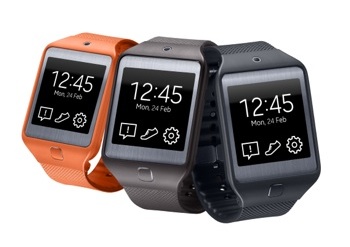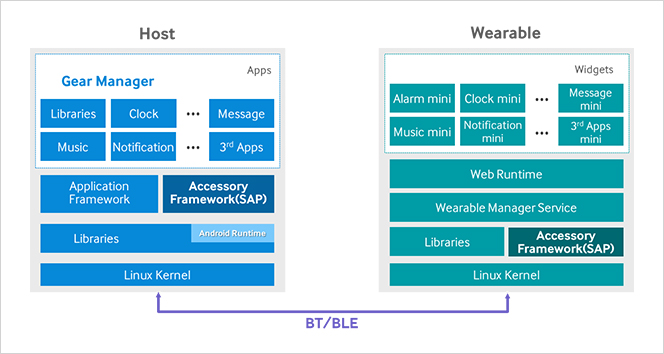 Like most smartwatches, Samsung’s Tizen Linux-based Gear 2 and Gear 2 Neo are primarily companion devices to Bluetooth connected smartphones rather than full-fledged wrist computers. Yet,the Tizen SDK for Wearablereleased by Samsung yesterday enables a variety of modes on the Gear watches for both standalone and companion scenarios.
Like most smartwatches, Samsung’s Tizen Linux-based Gear 2 and Gear 2 Neo are primarily companion devices to Bluetooth connected smartphones rather than full-fledged wrist computers. Yet,the Tizen SDK for Wearablereleased by Samsung yesterday enables a variety of modes on the Gear watches for both standalone and companion scenarios.
The open source Tizen software development kit includes a Tizen Wearable IDE for Ubuntu, Mac OS X and Windows desktops, as well as an emulator and tool-chain. Samsung also released a certification process for testing Gear apps, and a scheme for secure code signing.
The release arrived the day before Google announced its Android Wear wearable platform. This lightweight version of Android is now available as a developer’s preview, and will first appear in the G Watch, which LG briefly announced along with an image, but few details.
Due in the second quarter, the G Watch will be followed by a Motorola watch running Android Wear called the Moto 360. Expected this coming summer, the watch features an innovative — and yet retro – round watch face. According to Google, consumer electronics companies including Asus, HTC, and Samsung will also participate in the project, although it’s unclear whether Samsung, for example, would actually create an Android Wear smartwatch or instead add support for the platform in its industry-leading Samsung Galaxy phones and tablets. Google, also cited chipmakers Broadcom, Imagination, Intel, Mediatek, and Qualcomm as participants, as well as “fashion brands like the Fossil Group,” all of which will help “bring you watches powered by Android Wear later this year.”
The key enhancement in Android Wear is the integration of Google Now, letting users vocally query one’s smartwatch in natural language, starting with “Ok Google.” The “contextually aware” platform also extends Android’s notification system, with features such as stacked notifications, and adds support for various sensors. In addition, it offers more controls over your presumably Android-powered, Bluetooth connected phone.
It’s unclear how much control Google will extend over the hardware design; most likely. It will most likely follow the fairly loose requirements of an Android phone or tablet rather than the more strict guidelines it has used with Chrome OS and Google TV devices.
In the meantime, Samsung will have a several month head start on app development and the devices itself, now that it has released the Tizen SDK. Samsung’s Gear 2 and similar, but plastic-fabricated, Gear 2 Neo, will ship in April at an undisclosed price with 100 Tizen-based Gear apps (see farther below). The most stylish model, the swatch-like Gear Fit, runs a real-time operating system (RTOS) instead of Tizen, and will ship with a much smaller number of apps.
Wearable SDK details
The Tizen SDK for Wearable provides three app modes: one for simple, standalone Tizen widgets that don’t require Internet access, and two for linking Tizen widget apps with host apps running on the smartphone. In the future, the host could conceivably include mobile devices running Tizen, generic Android, or perhaps other OSes, but for now, it’s limited to Samsung devices running Android 4.3 or higher.
In the “Integrated” mode, an Android app and host-side Tizen app are packaged together in the host-side APK — the latter installs the widget on the smartwatch. In the “Master-Follower” mode, the Android host app and host-side Tizen Gear app are installed separately. This would presumably be used to add Gear connectivity to pre-existing Android apps.
The Gear apps make use of Tizen’s HTML5-based Web Runtime (WRT). The runtime communicates with the mobile device with the help of a Wearable Manager Service located on the watch and a Gear Manager on the mobile device. The Bluetooth, Bluetooth Lower Energy (BLE), or WiFi communications are brokered via a Samsung Accessory Protocol (SAP) service based on Samsung Mobile SDK 1.5. The 1.5 version, currently in beta, includes a new Accessory package that supports Gear connectivity for things like notifications and controlling music playback.

Accessory lets developers define services between a wearable and a smart device. Currently, the new Gear smartwatches are the only devices to support Accessory. However, Samsung envisions Accessory will not only run on future wearables, such as a health-related wearables or a potential Tizen-based eyewear device, but also for a variety of smart “Internet of Things” devices including automotive computers, gaming consoles, wireless speakers, or printers. It’s unclear whether these devices would similarly need to run Tizen or might also include Android devices. The Accessory page makes no mention of the Linux-based OS.
Like the original, Android-based Galaxy Gear smartwatch, the Gear 2 and Gear 2 Neo are equipped with a 1.63-inch Super AMOLED screen with 320 x 320-pixel resolution. Yet, they have a faster 1GHz, dual-core processor, backed up with 512MB RAM and 4GB flash. The watches include Bluetooth 4.0, as well as a 2-megapixel camera capable of 720p video.
Fitness features include a heart rate sensor, pedometer, accelerometer, gyroscope, and apps for running, walking, cycling, hiking, sleep, and stress monitoring. The devices add IP67 water and dust protection, and the 300mAh battery is said to last 2-3 days under typical usage.
23 apps, on the road to 100
Since the watches were announced in late February, the Gear now has 23 apps, a number that Samsung says should reach 100 by the April launch. In addition to apps for well-known brands like CNN, Conde Nast, eBay, and Expedia, Samsung announced music apps like MyMusicCloud and iHeartRadio, and a variety of health and fitness apps. The latter include Dacadoo, MapMyFitness, Strava, Runtastic, and Focus Trainr.
Social networking and location-related apps include Banjo, Glympse, Iwunta, and Life360. The remaining apps are a hodgepodge of productivity and media management apps such as Atooma, EasilyDo, Feedly, Spritz, Flick Dat, and News Republic. There’s even a wine-lover’s app (Vivino) and a Sleep Genius app for tracking and treating sleep disorders.
One would imagine that the other 70 or so apps that will be announced in late April will include some bigger names. Most likely, many of these will be Master-Follower apps that add Gear connectivity to an existing Android app.
Most app developers already know Android, so Samsung’s hybrid approach to Tizen app development shouldn’t be too large of a hurdle. The bigger question is whether developers will see a large enough market to justify the extra time and expense, especially for a platform that is limited by a requirement for connected Samsung smartphones and tablets. Although that encompasses most Android consumers, it’s still an extra limitation that won’t be an issue with most other smartwatch platforms, including Google’s.
Samsung will not only require a major marketing effort behind the Gear 2 watches, but will need to announce plans for future Tizen wearables that would expand the scope of the ecosystem to make it more appealing to developers and consumers. It also needs to attract more developers, something it has begun to do by recently by announcing 54 winners of over $4 million in Tizen App Challenge prizes.
The problem is that these apps were designed for Tizen smartphones, which appear to be delayed at least until the fall. Some of these apps might be converted to the Gear 2, but for the most part, entirely new apps will need to be developed.
In the meantime, however, developers have a flexible, open source SDK to help them get started. It’s unlikely that any other smartwatch will come along soon that will blow the Gear 2 out of the water. According to the current rumors, Google’s Nexus Watch will be very similar to the Gear 2 and most other smartwatches – i.e., a squarish device that most fashion-conscious types would never dream of wearing.
Within a year or two, however, further miniaturization and design efficiencies should enable a cool-looking bendable screen device like the Gear Fit that can run an advanced OS like Tizen or Android. Apple may have the design chops necessary to offer such a device this year, but if so, it’s likely to be initially priced beyond the scope of most consumers.
Meanwhile, Samsung has been doing its part to steer consumers toward wearables. For years it has been increasing the size of Galaxy smartphones to the point that people can no longer easily extract them from their pockets. Smartwatches to the rescue.


